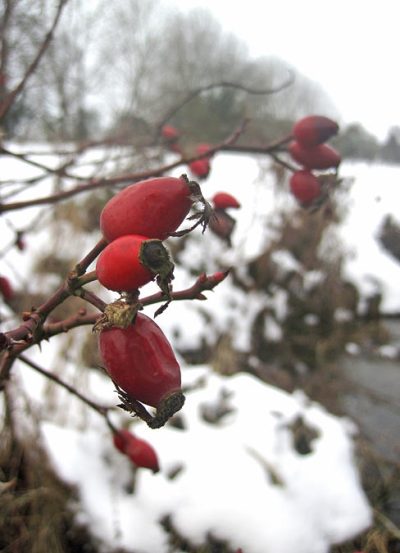The following post was written by Woodlore Aspirant Instructor Sarah Day:
Rose hips are one of my favourite wild foods, and the sight of a few of them clinging to an otherwise bare hedge is always welcome in late winter. They are delicious and full of vitamin C, but tricky to eat.
Those of you – and I’m sure there are a few! – who were (or are) practical jokers, may remember that the hairy insides of these innocuous looking fruits make a truly lethal itching powder. So remember that if you inadvertently eat the hairy bits from around the pips they have a similar effect internally; your digestive system will not thank you for it.
I have made rosehip syrup several times and it is delicious – really delicious – but it is a bit of a fiddle to make, and not really practical in the woods.
My favourite way to eat them when I’m out and about is to carefully pick those that have gone mushy (they turn a duller red), and squeeze the pulp out through the end where the rosehip was attached to the bush, using the index finger and thumb of both hands so it gets squeezed 4 ways.
Done carefully, you get a little nugget of pure rosehip – if you’re too rough the pips escape and get mixed in and you have to discard that one and try again….
The closest thing I can think of taste-wise is ripe kiwi fruit, but it’s not quite like anything else I can think of. There are still a few about, though I doubt they’ll stay for much longer. I spotted some fluffy Pussy Willow flowers on my canoe trip, almost out, Spring is nearly upon us!
– Sarah Day





Wild rosehip are much better than domestic rosehip. And very tasty, of course. To make a cup of tea it’s OK, but if you want to make some jam, it looks like an old chinese work. To separate rosehip pulp from their seeds and that fine hairs around seeds, will take too long if you want to make some rosehip jam, syrup or nectar. To do this i make myself an machine (see it here: http://catalinpastita.blogspot.com ) with that i can separate until 30 liters of pulp in an hour. All autumn, and later in winter we use raw rosehip pulp as nectar (or syrup), simple or mixed with honey-bee.
LikeLike
Hello sarah and Sean, I love rosehips but I collect them and make them into Jam or jellie preserves with some apples and a little lemon juice. I also collect crab apples for crab apple jelly, blackberries and wild damsons for jam and wine, elderberries for wine and sloes for gin!! All hedgerow fruits are free. Watching Ray gather wild food inspired me to have a go. There are plenty of recipies on the internet.
If you would like my tried and trusted ones, let me know.
regards. Maria
‘Comment of the Week’
LikeLike
@Ciaran Rooney: They’re the fruits of the dog rose/ wild rose. Very common in the UK, in amongst brambles and hedgerows.In early summer it has beautiful pink flowers
(fading to white in the middle)a ring of bright yellow stamens around the yellow sepals in the centre and generally 5-heart shaped petals.
You don’t get much fruity goodness from each one, but its a bit like eating little sweets as you walk and I find it easier than cutting them in half and scraping the bristles out- they seem to get everywhere!
LikeLike
You can make a tomato paste but i just eat them while i snowshoe or walk.
LikeLike
Never heard of Rose Hips before – gonna have a look for them soon, and see what all the fuss is about! Another great post Sarah – thanks a million!
LikeLike
great tips. I too have made rose hip syrup but was wondering about a more practical way to get those nice tasting vitamins and stuff 😉
LikeLike